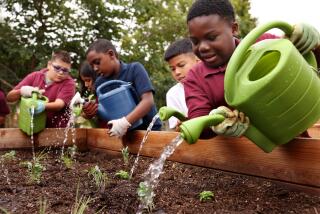the FEEL of BEAUTY : Gardening at the Braille Institute
- Share via
Geraldo Cruz moves with purpose through his garden, his hands gliding from plant to plant. He feels the leaves, squeezes the fruit, pauses to smell a blossom.
With skill and tenderness, he is nurturing a garden he will never see. Cruz is blind.
The 55-year-old Pacoima man is one of more than 1,000 visually impaired gardeners trained at the Braille Institute since 1973 to lead independent lifestyles through gardening.
Over the past 17 years, Cruz has surrounded his home on a quiet residential corner with the beauty and the bounty of nature.
Flowers bloom on one side of the house, and on the other sides, as Cruz said, “just follow your nose.”
The green pigeon peas are ready for harvest, as are the sweet yellow chili peppers, avocados, oregano, rosemary, beefsteak tomatoes and collard greens.
“The food goes straight from the garden to the kitchen,” he said.
Another Braille Institute gardener, Roger Oliphant, who grew up on a farm in Mississippi, works every day in a 425-square-foot plot behind his Crenshaw-area home.
“Enjoying the garden carries over into your everyday life. It makes your life better,” said Oliphant as he bent over a crop of turnips, using a magnifying glass to check an insect problem.
“I love the smell of the plants. I love to touch the plants,” said Geraldine Jefferson of South-Central Los Angeles. “I like others to see what I grow.”
Her collection of gardening prize ribbons almost outnumbers her house plants. Jefferson commutes--plants in hand--once a week to the gardening class run by volunteer instructor Carl Kahan at the Braille Institute’s Youth Center, 3450 Cahuenga Blvd. West, in the Universal City area.
Kahan has run the program since its inception 19 years ago at the center, where the facilities include a greenhouse, classroom, nursery, storage shed and, of course, a garden.
Blind gardening, Kahan said, “involves memorizing, imagery, touch and a little intuitiveness.”
Using slightly different techniques, the blind gardeners can enjoy freedom in their plots, he said. Wooden planting guides, seeds in salt shakers, magnifying glasses and Braille gardening books are their tools.
The guides help the blind gardeners space their plants 2, 4, 6 or 8 inches apart. Anything that sprouts in between is likely a weed, which the gardeners find by touch, and pull out.
Every Tuesday, following a classroom lecture on a seasonal gardening topic, as many as 15 blind gardeners and several sighted volunteers can be found using kneeling pads and planting guides, setting a crop of vegetables, fertilizing, weeding and harvesting their crops.
In the state-of-the-art greenhouse, others may be tending exotic orchids or the common pansy.
The annual Braille Institute Horticulture Show generates stiff competition. Prizes are awarded on the basis of appearance, Kahan said, a challenge for the blind.
As the soil is being prepared for another row of carrots and a row of beets, for Geraldo Cruz and the other blind gardeners it is time to till the soil, plant the seeds and prepare for the harvest.
Where to Call for Information
For more information about the Braille Institute’s Gardening Program, contact their Communications Department at (213) 663-1111.






